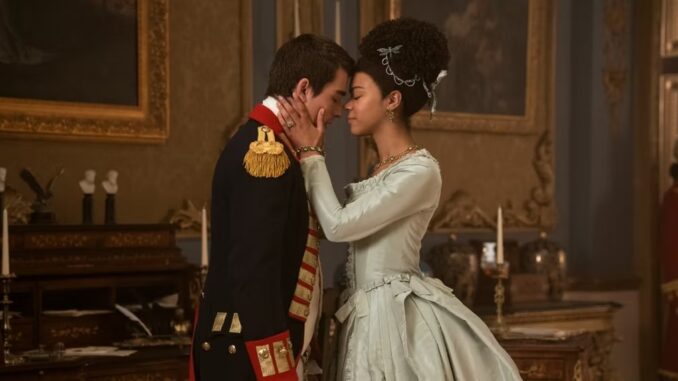
From the moment that Queen Charlotte: A Bridgerton Story was announced, it was quite clear that showrunner Shonda Rhimes had a much different task from her Bridgerton counterpart, Chris Van Dusen. Some would say that her job was even more difficult. After all, she wasn’t dealing with entirely fictional love stories based on tried and true romance tropes, but with a real-life affair. Her mission was to turn a real historical arrangement between two European monarchies into an engaging love story. Besides that, she would also have to work with a couple that was already married instead of playing with the obstacles that keep two would-be lovers from getting together. Queen Charlotte is the kind of story that had everything to be one dull slice-of-life, with little to no excitement — but, thankfully, it is not.
Instead, Queen Charlotte avoids its pitfalls by focusing on the messier, more realistic aspects of romantic relationships. Through its portrayal of Queen Charlotte (India Amarteifio) and King George’s (Corey Mylchreest) relationship, the show disabuses us of the notion that love is merely a fortuitous thing that happens between two young people. Over and over again, the Netflix miniseries reiterates that love is indeed something quite complicated that often takes a lot of work. A love story doesn’t end at the altar, as Bridgerton and many other romance stories would have us believe. If a couple is lucky, their love will endure for many years after the wedding, sometimes even for a whole life. Over this period of time, those once carefree lovers will come across hardships that usually don’t find a place in romance — things like mental illness, responsibilities, and toxic family relationships. In Queen Charlotte, however, these things are more than just dealt with: they make up the core of the story, helping create a show that focuses not on the pretty, honeymoon phase of a relationship, but on its messier side.

‘Queen Charlotte’ Portrays What It’s Like to Love Someone with a Mental Illness
The most prominent aspect of Queen Charlotte’s realistic approach to romance is, of course, its depiction of King George’s so-called “madness”. The show has no qualms about making its romantic lead a man living with a mental illness, and that on its own is already a good thing. After all, mentally ill people fall in love all the time in the real world, and having a psychological or neurological disorder doesn’t make anyone unworthy of affection. It is truly sad that there aren’t more mainstream romance stories featuring ill characters.
But Queen Charlotte’s merits on this topic don’t stop at the mere depiction of mental illness. The show also deserves praise for how it makes George’s condition an integral part of his relationship with Charlotte. His illness isn’t merely an obstacle that can be remedied with love, but something with which both George and Charlotte have to live for the rest of their lives. Through this portrayal of what it’s like to be both mentally ill and in a relationship with someone who is mentally ill, the series tackles issues of self-esteem, stigmatization, and acceptance.
Granted, for at least the first few episodes of Queen Charlotte, King George’s illness is indeed presented as an obstacle to his relationship with his wife. When Princess Charlotte first meets the king and subsequently marries him, she isn’t aware of his illness. George, on the other hand, does his best to hide his symptoms from her, believing himself to be unworthy of her love due to his condition. Out of despair and an overall feeling that he isn’t good enough, he accepts and even seeks out inhumane medical treatments in order to get better. These treatments, of course, don’t work, and George is forced to learn the best way to live with his mental illness.
Charlotte, on the other hand, has her own path of acceptance regarding George’s condition. Initially, she’s angry at her husband for not being around for their honeymoon. Left alone and completely in the dark as to what is going on, she begins to suspect that there is something amiss when she catches a glimpse of Dr. Monro (Guy Henry) “treating” the king. Little by little, she learns of her husband’s afflictions and is initially taken aback by them. George’s illness becomes just one more item on the list of things that make life in England unbearable for the new queen. However, as it becomes clear that leaving this new life behind isn’t a choice, Charlotte slowly begins to accept George as he is, protecting him from Monro and even developing her own ways of helping him through his episodes.
The way in which this story is presented relationship in Queen Charlotte highlights the importance of honesty and collaboration in a, as well as the role our choices play in keeping love alive and strong.
